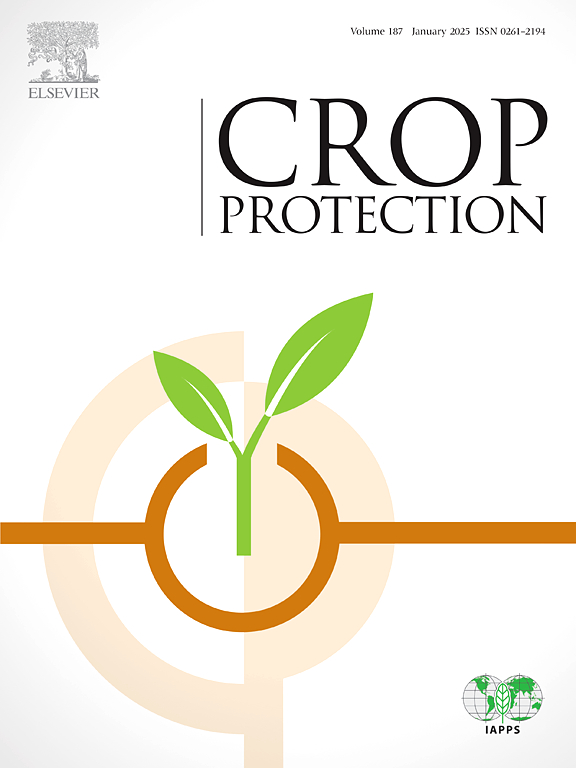In vitro and in vivo compatibility of isocycloseram-based insecticides with entomopathogenic fungi used for corn leafhopper management
IF 2.5
2区 农林科学
Q1 AGRONOMY
引用次数: 0
Abstract
Recently registered, isocycloseram-based insecticides have the corn leafhopper (Dalbulus maidis) as a main target in Brazil. Nevertheless, the management of this vector is complex and requires the integration of strategies, including chemical and fungal agents. Here, we investigated the compatibility of mycoinsecticides based on isolate Esalq-1296 of Cordyceps javanica and Simbi BB15 of Beauveria bassiana with isocycloseram-based insecticides and their mixtures. In vitro, the biological index adopted indicated that the insecticide based on isocycloseram + lambda-cyhalothrin (at 125- and 250-mL ha−1) was classified as moderately compatible with the Esalq-1296 isolate of C. javanica and Simbi BB15 of B. bassiana. The isocycloseram-based formulation was classified as compatible with the Simbi BB15 isolate of B. bassiana, at both doses tested, and moderate compatible and compatible with the Esalq-1296 isolate of C. javanica at 100 and 50 mL ha−1, respectively. Further analysis revealed that the majority of insecticide-mycoinsecticides mixtures exhibited physicochemical compatibility, with the exception of the mixture comprising these insecticides and the mycoinsecticide-based on B. bassiana (FlyControl®), which demonstrated an absence of homogeneity. The in vivo bioassays demonstrated an additive effect on leafhopper mortality and an increase in the velocity of lethal toxicity when these insecticides (at LC30) were combined with the tested mycoinsecticides. However, the insecticides reduced the extrusion rate and sporulation from dead leafhoppers. As these parameters are crucial for fungal persistence by establishing a secondary cycle of epizootics in cornfields, caution is advised when combining these chemical and fungal agents for the management of D. maidis.
异环菌胺类杀虫剂与玉米叶蝉昆虫病原真菌的体内外相容性研究
在巴西,最近登记的以异环虫胺为基础的杀虫剂以玉米叶蝉(Dalbulus maidis)为主要目标。然而,这种病媒的管理是复杂的,需要综合各种战略,包括化学和真菌制剂。本研究以紫虫草Esalq-1296和球孢白僵菌Simbi BB15为分离物,研究了真菌类杀虫剂与异环菌酰胺类杀虫剂及其配伍剂的相容性。体外生物学指标表明,以异环丝氨酸+高效氯氟氰菊酯为基础的杀虫剂(在125和250-mL ha−1时)与javanica的Esalq-1296分离株和bassiana的Simbi BB15分离株具有中等相容性。基于异环血清的制剂在两种剂量下均与球孢白僵菌Simbi BB15分离物相容,在100和50 mL ha -1剂量下分别与javanica菌Esalq-1296分离物相容。进一步分析表明,大多数杀虫剂-真菌杀虫剂混合物具有物理化学相容性,但含有这些杀虫剂的混合物和基于球孢白僵菌(FlyControl®)的真菌杀虫剂表现出不均匀性。体内生物测定表明,当这些杀虫剂(LC30)与所测真菌杀虫剂联合使用时,叶蝉死亡率和致死毒性的速度增加。然而,杀虫剂降低了叶蝉死亡的挤出率和产孢量。由于这些参数对真菌的持久性至关重要,通过建立玉米田动物流行病的二次循环,因此建议在联合使用这些化学和真菌制剂来管理麦地那虫时要谨慎。
本文章由计算机程序翻译,如有差异,请以英文原文为准。
求助全文
约1分钟内获得全文
求助全文
来源期刊

Crop Protection
农林科学-农艺学
CiteScore
6.10
自引率
3.60%
发文量
200
审稿时长
29 days
期刊介绍:
The Editors of Crop Protection especially welcome papers describing an interdisciplinary approach showing how different control strategies can be integrated into practical pest management programs, covering high and low input agricultural systems worldwide. Crop Protection particularly emphasizes the practical aspects of control in the field and for protected crops, and includes work which may lead in the near future to more effective control. The journal does not duplicate the many existing excellent biological science journals, which deal mainly with the more fundamental aspects of plant pathology, applied zoology and weed science. Crop Protection covers all practical aspects of pest, disease and weed control, including the following topics:
-Abiotic damage-
Agronomic control methods-
Assessment of pest and disease damage-
Molecular methods for the detection and assessment of pests and diseases-
Biological control-
Biorational pesticides-
Control of animal pests of world crops-
Control of diseases of crop plants caused by microorganisms-
Control of weeds and integrated management-
Economic considerations-
Effects of plant growth regulators-
Environmental benefits of reduced pesticide use-
Environmental effects of pesticides-
Epidemiology of pests and diseases in relation to control-
GM Crops, and genetic engineering applications-
Importance and control of postharvest crop losses-
Integrated control-
Interrelationships and compatibility among different control strategies-
Invasive species as they relate to implications for crop protection-
Pesticide application methods-
Pest management-
Phytobiomes for pest and disease control-
Resistance management-
Sampling and monitoring schemes for diseases, nematodes, pests and weeds.
 求助内容:
求助内容: 应助结果提醒方式:
应助结果提醒方式:


